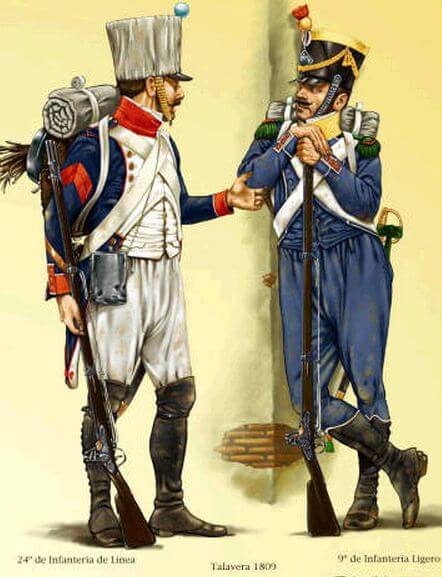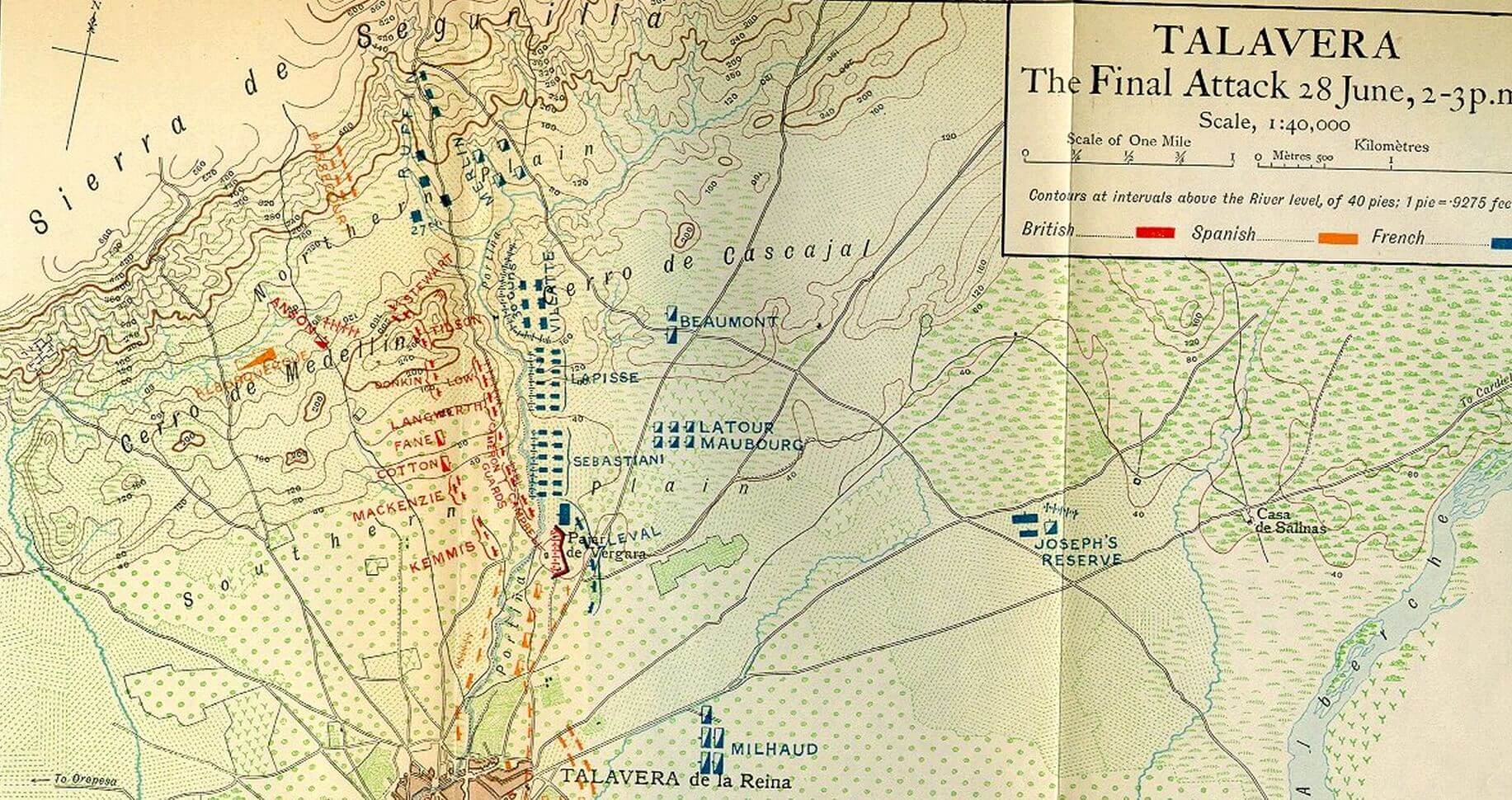Talavera Background:
Forces:
This battle was one of the major battles fought in the longest campaign of the Napoleonic Wars: the six-year Peninsular Campaign. The British victory is surrounded by a degree of controversy – especially as LG Sir Arthur Wellesley was subsequently created Baron Douro and Viscount Wellington of Talavera. Military historians continue to debate the Anglo-Spanish troop deployment as well as the battle’s strategic importance (the French retreated from the battlefield on the night of 28-29 July with a loss of 7,268 men; Wellesley’s army retired to Balajoz on the Spanish-Portugese border in early August). Anglo-Spanish casualties on 28 July had been 5,365 (mostly British). With Forces split almost evenly 50,000 Spanish and British troops versus approximately 46,000 French, the attack by the French was bold given the terrain and defensive positions.
King Joseph’s Army of the Center was composed of three formations, which united for the Battle of Talavera de la Reyna: Marshal Claude-Victor Perrin [dit Victor]’s 20,000 men from Merida; GdD Horace-Francois-Bastien, Comte Sebastiani’s 22,000 men from Madridejos; and Joseph’s 12,000 men from Madrid. Many sources put the French strength on 28 July at 42,000-46,000 men and 80-82 guns – approximately 35,000 infantry and 7,000 cavalry – with an unknown number of non-combat units and personnel.
The Army of the Center was not an entirely-French formation. GdD Jean-Francois Leval’s 2nd Infantry Division of Sebastiani’s IV Corps was composed of troops from Baden, Hesse-Darmstadt and Holland. There was also a Polish lancer regiment and a Westphalian cheveauxleger regiment in GdB Christophe-Antoine Merlin’s light cavalry division of the French Reserve Cavalry. One sources also lists four squadrons of the 3rd (Dutch) Hussar Regiment with I Corps’ cavalry brigade.
Joseph’s chief-of-staff was Marshal Jean-Baptiste Jordan, a French officer who spent most of his Empire war service in Naples and Spain (as a side-note, Jourdan did not possess a dual title – a rarity in the Marshalate – although King Louis XVIII made him a count in 1815). Jourdan had been the commander of the French Army of the Moselle at the Battle of Fleurus (26 June 1794).
The Plan & what Happened:

Victor’s reinforced French army faces off against a larger British/ Spanish army in superb defensive positions. The French solution—attack! Ruffin’s French division is wrecked in two unsupported assaults on the British positions atop the Cerro de Medellín. It is now mid-morning of July 28th 1809, and the French commanders meet.
They decide to launch concentric attacks. Victor shifts Ruffin’s survivors to the right and supports them with one of Villatte’s brigades.

Sebastiani’s fresh division fills the gap. The plan is for Sebastiani’s division to attack first .
Leval’s division is to attack second following Sebastiani’s frontal attack against the Allied lines, but Leval’s troops lose sight of the French lines, and attack first.
The French columns lose cohesion as they advance through the trees and emerge disorganized onto the open ground directly in front of the Spanish batteries on Pajar de Vergara.

The French regiments still make some progress, but the central regiment finally breaks under the impact of the artillery fire. Seeing this, the Allies counter attack and Leval’s depleted regiments retreat to avoid being isolated.
On the French far left, Milhaud, the cavalry commander, recognizes the strength of the Spanish position in and around Talavera and is content to skirmish with the Spaniards in this part of the battlefield.
On the French far left, Milhaud, the cavalry commander, recognizes the strength of the Spanish position in and around Talavera and is content to skirmish with the Spaniards in this part of the battlefield.
The British maintain their positions for twenty-four hours, and then retreat hurriedly when they learn that Soult and a second French army are marching to cut their lines of communication with Portugal. The French claim a victory, even though they were soundly beaten in all of their attacks.
By Kent Reuber:
I got together with 3 friends to play both sides of the Talavera scenario. The French right flank portion is included in the base C&CN while the French left scenario is included in the Spanish Army expansion. We had some hopes of trying a “La Grande” battle (similar to Epic Ancients), but ran out of time, and ended up playing 2 one-on-one games. Initially, we tried synchronizing turns so that both flanks were playing cards and executing turns at the same time, but we quickly abandoned this.
The setup is shown above. As you can see, the river sections don’t match. There is an alternate scenario on http://www.ccnapoleonics.net/Maps/Peninsular-War-1808-1814/md06-talavera-epic-28-july-1809.html where the two halves of the board match up better. Also note, that the borders on the board prevent you from doing seamless two-board scenarios. I’d like to suggest to GMT that if there’s ever a reprint, that these boarders be trimmed.
I played the French left flank commander. I advanced my artillery on the left to bring fire to bear on the British infantry. They obliged by charging my guns and were blown away. There was a lot of action on the left flank as the woods changed sides back and forth. In the end, most of the French cavalry were driven off, including a magnificent roll of 3 cavalry dice thrown during a Retire and Reform maneuver. I had 5 banners (6 needed to win), and decided to go after a couple of heavily damaged Spanish infantry units in the center. However, it was not to be as the Spanish guerilla’s were in full force, disrupting the French final assault. In the end, I lost 6 banners to 5.
Left Board Final above and Right Board below:
On the right board terrain limits action. The British attack aggressively. The French stand their ground and use terrain to their advantage preventing any flanking. The French Artillery and men on the hill erode the British attack.
In this case, the French won 7 banners to 6, which meant a tie for both battles.



